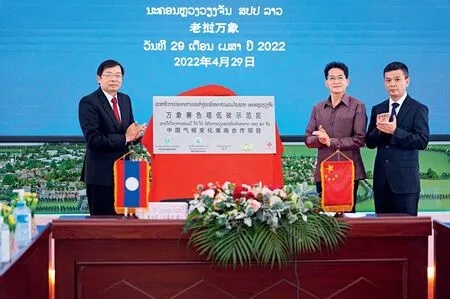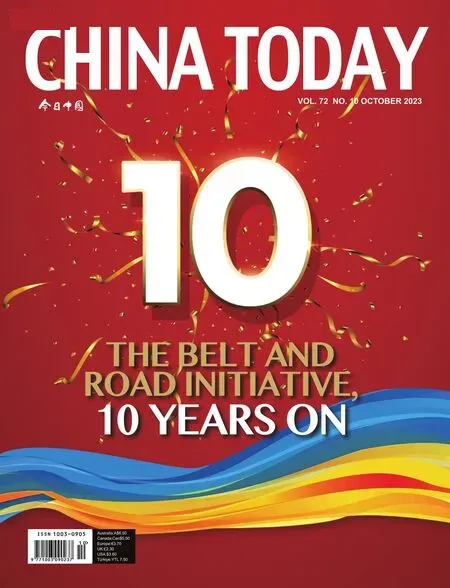China-Laos Green Zone Epitomizes BRI
By staff reporter ZHOU LIN

The inauguration ceremony of the Vientiane Saysettha Low-Carbon Demonstration Zone,jointly built by China and Laos,is held on April 29,2022.
The project is expected to create a low-carbon demonstration area which can become an ecofriendly model for Laos and other Southeast Asian countries.
T HE Saysettha Development Zone in the new town of Vientiane,capital of Laos,is a sprawling swathe of lush vegetation in late summer.The many flowers and shrubs are irrigated through an advanced water circulation system that uses pipes embedded underground.To illuminate the city’s asphalt roads,2,000 China-aided solar LED streetlights have been installed,while on the main avenue new energy buses transport workers to the industrial park and residential areas nearby.
This development zone is a cooperative project between China and Laos under the Belt and Road Initiative (BRI),expected to create a low-carbon demonstration area which can become an eco-friendly model for Laos and other Southeast Asian countries.
Joint Efforts to Tackle Climate Change
In November 2015,at the opening ceremony of the Paris Conference on Climate Change,Chinese President Xi Jinping delivered a keynote speech entitled “Work Together to Build a Win-Win,Equitable and Balanced Governance Mechanism on Climate Change.” He announced that China would launch cooperation projects to set up 10 pilot low-carbon industrial parks and start 100 mitigation and adaptation programs in other developing countries,providing them with 1,000 training opportunities on climate change.These flagship programs of South-South Cooperation on Climate Change are part of China’s active participation in global governance and pragmatic measures to push forward the BRI and the country’s opening-up.
The Saysettha Development Zone is one of the flagship programs put into practice after Xi’s announcement.It is also part of the action plan on building a China-Laos community with a shared future,which fully demonstrates the two countries’ determination in advancing green and low-carbon development and responding to climate change.
The Lao-China Joint Venture Investment Co.,Ltd.,a subsidiary company of Yunnan Construction and Investment Holding Group,is the builder of the Saysettha Development Zone.It began to coordinate with the Ministry of Ecology and Environment of China and the Ministry of Natural Resources and Environment of Laos in 2019 for implementing the project.
Xiong Jun,general manager of Lao-China Joint Venture Investment Co.,Ltd.,said that it took them four years from the preparation to application and to the construction.In the process,they had to contact government authorities,customs,production enterprises,and logistics companies.Whenever they encountered difficulties,the two sides would communicate in a timely manner and identify the right solution accordingly.
Sengalounthon Bouphasvanh,a Lao employee and assistant to the general manager of Lao-China Joint Venture Investment Co.,Ltd.,is responsible for the outreach work of the Lao government in the core team of the project.She is proud to have witnessed the whole process.On July 16,2020,she said,the memorandum of understanding (MOU)between the Ministry of Ecology and Environment of China and the Ministry of Natural Resources and Environment of Laos on the Cooperation in the Construction of the Saysettha Development Zone was officially signed,which marked the listing of the project as one of the 10 pilot low-carbon industrial parks aided by China in other developing countries.
According to the MOU,the two sides would jointly build the Saysettha Development Zone into a low-carbon demonstration area.It is expected to drive the lifestyle transformation with low-carbon transportation,improve green infrastructure with low-carbon lighting,and enhance Laos’capability and awareness of low-carbon development in responding to climate change through capacity building,technical exchanges and publicity activities,so as to effectively promote green and sustainable development.
The Ministry of Ecology and Environment of China also worked with its Lao counterpart in compiling the construction plan for the low-carbon demonstration zone,and donated solar LED streetlights,environmental monitoring equipment,new energy buses and trucks,as well as vehicles for environmental law enforcement,to support Laos’ response to climate change.
A Model for Green Development
In 2021,the global spread of COVID-19 increased the difficulty of cross-border work.Xiong Jun said that the materials donated by China were transported from the country to Vietnam and then to Laos,which required coordination with many parties from customs to logistics.They had to overcome numerous difficulties from epidemic control,reloading at ports,and overseas transportation.
In September 2021,the first batch of 2,000 sets of solar LED streetlights and five sets of environmental monitoring equipment from China finally arrived in Vientiane.In November,all the solar streetlights were installed,lighting up the industrial park.The energy-saving streetlights meet the night lighting needs of employees and local residents within two kilometers and ensure their safety in work,life and transportation.
On April 29,2022,the inauguration ceremony of the Saysettha Development Zone as a project of the South-South cooperation on climate change between China and Laos was held in Vientiane.Twelve new energy buses,eight new energy trucks and eight environment law enforcement vehicles were delivered to Laos in the second batch of aid materials from China.All the promised aid in the MOU had been delivered.

New energy vehicles are delivered to Laos from China to aid Laos’response to climate change.
“New energy buses can solve the commuting problem of 1,000 to 1,500 people,helping enterprises in the industrial park hire more employees,and also improve their form of transportation.It provides a green,low-carbon and environmentally friendly way to meet the needs of local people,and also establish an operation mode for the building of the green economic development zone,” said Xiong Jun.
The new energy buses were put into operation on March 25,2023.On that day,all new bus routes launched in the city of Vientiane adopted new energy buses.The bus routes passing through the Saysettha Development Zone have brought great convenience to employees in the industrial park.These new energy vehicles can reduce carbon emissions by about 1,243 tons annually,equivalent to planting more than 100,000 trees.
Sengalounthon Bouphasvanh added that there is a large demand for enterprises to transport construction materials,raw materials,machinery and equipment,and finished products,with the average daily cargo traffic reaching 1,000 to 1,500 tons.Compared with the noise,pollution and exhaust emissions caused by conventional trucks,the eight new energy trucks donated by China can cover about 60 to 75 percent of the transportation volume in the area,besides the additional service of transporting some special equipment,which has greatly reduced pollution.

The entrance gate of the Saysettha Development Zone in the new town of Vientiane,capital of Laos.
At present,the development zone has attracted 131 enterprises from China,Japan,Singapore,Thailand,and other countries and regions,with a total investment of more than US $1.5 billion and 6,000 workers.It is expected that by 2025,the total number of enterprises in the industrial park will reach 200,with over 20,000 employees.A modern,green and smart new city is taking shape in Vientiane with beautiful scenery.
For the Well-Being of Locals
In addition to assisting with many of the materials,the Chinese government also helped with the installation and maintenance of streetlights and the charging,driving and maintenance of new energy vehicles.Xiong Jun said that due to the pandemic,all training was conducted online.From February to March 2022,23 staff members in the industrial park were trained to drive new energy vehicles.
“We have mastered the daily operation,maintenance and repair of new energy vehicles,and hope to make our own contribution to the low-carbon transition,” said a Lao employee named Kiengkham.
Bounkham Vorachit,minister of natural resources and environment of the Lao People’s Democratic Republic,pointed out that the building of a low-carbon demonstration area in Vientiane has set a benchmark for other regions to save expenses and also reduce air pollution.It is an active response to the Lao government’s strategic plan of using renewable energy and clean electricity.
The Saysettha low-carbon demonstration zone has promoted green technology,green equipment and green industry,cultivated green production and lifestyles,as well as popularized the idea of green and sustainable development among locals.
“It has brought us tangible benefits.After the new energy buses were launched,it has become more convenient for us,and the solar streetlights illuminate our way home from work.I feel so grateful to the Chinese government,” said Lao employee Tongkhoun Langlounchan.
Vadsana lives nearby.“We are no longer afraid of going out at night now that we have streetlights,and I can exercise every day by bike.And the production in the industrial park is all environmentally friendly.It also drives the development of the surrounding regions and increases people’s income.We are all looking forward to the completion of this new garden city,” he said.
“A low-carbon demonstration area is a new concept in Laos,and we are proud of turning it into reality,” added Tongkhoun Langlounchan.

